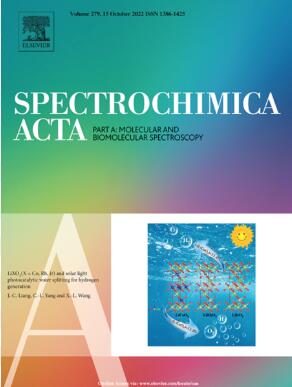A novel supramolecular zinc porphyrin thin film coated fiber optic Mach − Zehnder interferometer for trace detection of ammonia gas
IF 4.3
2区 化学
Q1 SPECTROSCOPY
Spectrochimica Acta Part A: Molecular and Biomolecular Spectroscopy
Pub Date : 2025-06-28
DOI:10.1016/j.saa.2025.126575
引用次数: 0
Abstract
A novel fiber-optic ammonia Mach-Zehnder interferometer (MZI) with an asymmetric-sensing structure was developed and experimentally validated. The sensor was fabricated through successive fusion splicing of single-mode fiber (SMF), coreless fiber (NCF), SMF, thin-core fiber (TCF), and SMF, thereby forming an SMF-NCF-SMF-TCF-SMF interferometric structure. Experimental and simulation results demonstrated that the sensor exhibited a linear response within the refractive index range of 1.3320–1.3636. Using the layer-by-layer (LbL) self-assembly technique, ultrathin two-dimensional (2D) self-assembled tetrakis(4-carboxyphenyl) zinc porphyrin (SA-ZnTCPP) and zinc acetate (Zn(OAc)2) nanoporous films were deposited onto the fiber sensing region. The structural, morphological, and compositional properties of the nanomaterials and films were analyzed via Fourier-transform infrared (FT-IR) spectroscopy, ultraviolet–visible (UV–Vis) absorption spectroscopy, X-ray diffraction (XRD), X-ray photoelectron spectroscopy (XPS), and scanning electron microscopy (SEM). NH3 adsorption by the thin film modifies the sensor’s effective refractive index, enabling gas detection. Experimental results revealed that the interference intensity of the monitoring peak increased proportionally with NH3 concentration. Within the 0–600 ppb range, the sensor demonstrated high sensitivity (7.12 dB/ppm) and linearity, achieving a detection limit of 2 ppm with response-recovery times of 40 s and 50 s, respectively. The sensor demonstrates notable advantages, including high sensitivity, excellent selectivity, straightforward design, and ultra-low detection limits, indicating strong potential for toxic NH3 monitoring in chemical engineering and industrial applications.

一种新型超分子锌卟啉薄膜涂层光纤Mach - Zehnder干涉仪用于微量氨气检测
研制了一种具有非对称传感结构的新型光纤氨Mach-Zehnder干涉仪,并进行了实验验证。该传感器通过单模光纤(SMF)、无芯光纤(NCF)、SMF、薄芯光纤(TCF)和SMF的连续熔接制成,从而形成SMF-NCF-SMF-TCF-SMF干涉结构。实验和仿真结果表明,该传感器在1.3320 ~ 1.3636折射率范围内具有良好的线性响应。采用逐层(LbL)自组装技术,将超薄二维(2D)自组装的四(4-羧基苯基)卟啉锌(SA-ZnTCPP)和醋酸锌(Zn(OAc)2)纳米孔膜沉积在光纤传感区。通过傅里叶变换红外(FT-IR)光谱、紫外-可见(UV-Vis)吸收光谱、x射线衍射(XRD)、x射线光电子能谱(XPS)和扫描电子显微镜(SEM)分析了纳米材料和薄膜的结构、形态和组成特性。薄膜对NH3的吸附改变了传感器的有效折射率,使气体检测成为可能。实验结果表明,监测峰的干扰强度随NH3浓度成比例增加。在0-600 ppb范围内,该传感器具有较高的灵敏度(7.12 dB/ppm)和线性度,检测限为2 ppm,响应恢复时间分别为40 s和50 s。该传感器具有灵敏度高、选择性好、设计简单、超低检出限等显著优势,在化学工程和工业应用中具有很强的毒性NH3监测潜力。
本文章由计算机程序翻译,如有差异,请以英文原文为准。
求助全文
约1分钟内获得全文
求助全文
来源期刊
CiteScore
8.40
自引率
11.40%
发文量
1364
审稿时长
40 days
期刊介绍:
Spectrochimica Acta, Part A: Molecular and Biomolecular Spectroscopy (SAA) is an interdisciplinary journal which spans from basic to applied aspects of optical spectroscopy in chemistry, medicine, biology, and materials science.
The journal publishes original scientific papers that feature high-quality spectroscopic data and analysis. From the broad range of optical spectroscopies, the emphasis is on electronic, vibrational or rotational spectra of molecules, rather than on spectroscopy based on magnetic moments.
Criteria for publication in SAA are novelty, uniqueness, and outstanding quality. Routine applications of spectroscopic techniques and computational methods are not appropriate.
Topics of particular interest of Spectrochimica Acta Part A include, but are not limited to:
Spectroscopy and dynamics of bioanalytical, biomedical, environmental, and atmospheric sciences,
Novel experimental techniques or instrumentation for molecular spectroscopy,
Novel theoretical and computational methods,
Novel applications in photochemistry and photobiology,
Novel interpretational approaches as well as advances in data analysis based on electronic or vibrational spectroscopy.

 求助内容:
求助内容: 应助结果提醒方式:
应助结果提醒方式:


